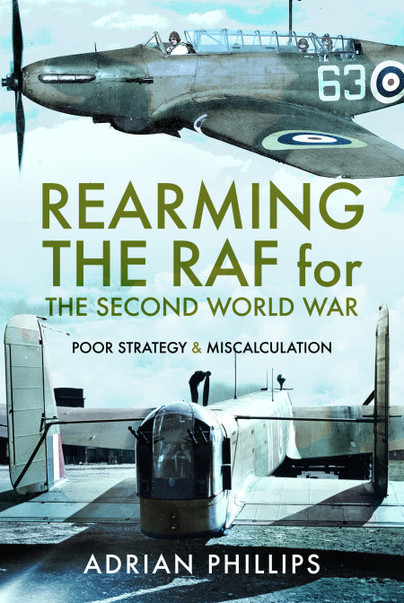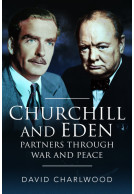Rearming the RAF for the Second World War (Hardback)
Poor Strategy and Miscalculation
Imprint: Pen & Sword History
Pages: 368
Illustrations: 40 black and white illustrations
ISBN: 9781399006248
Published: 15th June 2022
(click here for international delivery rates)
Order within the next 11 hours, 4 minutes to get your order processed the next working day!
Need a currency converter? Check XE.com for live rates
When the RAF rearmed to meet the growing threat from Nazi Germany's remorseless expansion in the late 1930s, it faced immense challenges. It had to manage a huge increase in size as well as mastering rapid advances in aviation technology. To protect Britain from attack, the RAF's commanders had to choose the right strategy and the right balance in its forces. The choices had to be made in peacetime with no guidance from combat experience. These visions then had to be translated into practical reality. A shifting cast of government ministers, civil servants and industrialists with their own financial, political and military agendas brought further dynamics into play. The RAF's readiness for war was crucial to Britain's ability to respond to Nazi aggression before war broke out and when it did, the RAF's rearmament was put to the acid test of battle. Adrian Phillips uses the penetrating grasp of how top level decisions are made that he honed in his inside accounts of the abdication crisis and appeasement, to dissect the process which shaped the RAF of 1940. He looks beyond the familiar legends of the Battle of Britain and explores in depth the successes and failures of a vital element in British preparations for war.
"...a valuable contribution to the historiography of World War II and the challenges of rearmament during the interwar period. Phillips’ analysis is rigorous and well-supported, and his insights are likely to be of interest to scholars and general readers alike."
History: Review of New Books
Looks at the methodologies – or lack of them – that led to the force-structure requirements and threat projections that set the direction of RAF rearmament, as expressed in these modernization plans, in the critical prewar years.
The NYMAS Review
This is a book for anyone with an interest in the history of the RAF and the Second World War.
Journal of Military History
The chapters analysing the relationship between the wider government and the Air Ministry are the most engaging. They provide a real depth of understanding of the dynamics at play between the two.
From Balloons to Drones.
As Featured in.
The Aviation Historian Jan 2023 Issue No.42
"Makes a substantial contribution to the historiography of the period."
RAF Historical Society Journal
Highly recommended to those interested in the how personalities affect doctrine and technology.
Air & Space Power History
This book provides in depth analysis on the extent to which the RAF was ready for war, and how this was crucial to Britain’s ability to response to German aggression prior to war breaking out when it did. The book develops how decisions made at the top to ultimately step the RAF position in 1940. The book itself goes far beyond the story of the Battle of Britain, and develops how in order to defend Britain from attack, crucial decisions had to be made during peace time, before any combat had taken place.
Jon Sandison
"Rearming the RAF is meticulously researched. An intriguing read......"
Australian Naval Institute
Read the review here
This is a subject that's close to my heart - my Dad was in a reserved occupation during the war, working in the Gloster Aircraft Factory to provide armaments for the British forces, in particular the air force.
Books Monthly
I have to say what a fascinating book and the subject I find is so interesting. Primarily this is a book that looks at the competition and infighting in and amongst the RAF, but not only that, but also the unnecessary fighting with the other arms of the armed forces and other organisations. Quite a bit of the book revolves around what the RAF stood for or what it wanted to concentrate on, for example, it was torn between infighting over whether to concentrate on prioritising small fighter aircraft of big heavy bombers. Basically, it’s like having a kitchen and someone has employed a lot of chefs and they all have to try and work together with the right menu.
The History Fella
A very good book and quite thought-provoking and sometimes I was left thinking how on earth did the RAF succeed, but I really enjoyed reading it because there was lots of research and because it made me think. Plus I’m not sure the average joe in the street realises this was how the armed forces were run, we never hear about this in the mainstream media. A blinking good read by author Adrian Phillips, one I most certainly recommend.
Read the full review here
A compelling, sometimes shocking and always thought provoking description of what happens when blind prejudice, bureaucratic infighting and ill-formed theories are allowed to determine defence policy, equipment procurement and the security of the nation.
Robert Lyman, author of 'A War of Empires: Japan, India, Burma & Britain: 1941-45'
A detailed and highly readable account of how the RAF became obsessed with the bomber in the decades before the Second World War, yet even after six years of continual expansion Bomber Command was unable to mount a credible offensive against Germany in 1940. Adrian Phillips skilfully uses archival sources to show how the clash of personalities inside Whitehall combined with false orthodoxies within the Air Ministry to leave Britain with no counter to Hitler's Luftwaffe - except, almost by accident, the Spitfires and Hurricanes of Fighter Command.
Brett Holman, author of 'The Next War in the Air: Britain's Fear of the Bomber, 1908–1941'
About Adrian Phillips
After a career as an investment analyst and strategist in London and Frankfurt with a special focus on the political influences on markets, Adrian returned to university for a postgraduate degree in history, which had long been his passion. He focused on how top level decisions were taken in Whitehall and how bureaucrats could often wield greater power than politicians. This features in his books: The King Who Had To Go, which covered the abdication and Fighting Churchill, Appeasing Hitler, which covered appeasement. Rearming The RAF applies his knowledge of how the hidden mechanisms of power operate to military strategy.
The RAF Regiment at War 1942–1946 (Paperback)
Born out of necessity in the dark days of the War, the RAF Regiment found itself in the thick of the action supporting the vital operations in all theatres. This comprehensive record of their operations gives the clearest indication of the contribution that the Regiment made and includes many first hand accounts of the fighting, including the first shooting-down of a jet aircraft, the Me 262A-2a Sturmvogel in November 1944. As a result of their outstanding contributions to the success of RAF operations in WW2, the Regiment became a permanent part of the RAF.
By Kingsley OliverClick here to buy both titles for £39.99

















